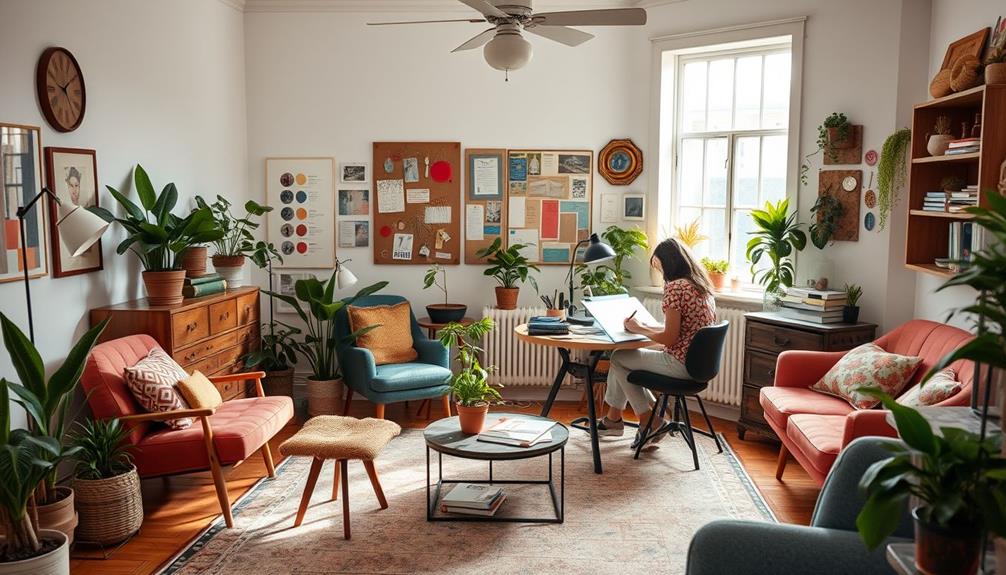Embarking on the journey of starting an interior design business involves multiple steps, and one of the most critical is understanding how to register your interior design firm. This essential process not only establishes your legal standing within the industry but also enhances your credibility with potential clients. By ensuring proper interior design business registration, you lay down a solid foundation for your practice and protect your brand identity in a competitive market.
As you dive into starting an interior design business, this guide will equip you with the necessary knowledge and steps to navigate the registration process smoothly. From choosing a business name to securing an Employer Identification Number (EIN), every detail counts in building a legitimate and thriving venture. Let’s kick start your journey with clarity and confidence!
Key Takeaways
- Registering your firm enhances credibility and legal reliability.
- Understanding state-specific requirements is crucial for compliance.
- An Employer Identification Number (EIN) simplifies tax processes.
- Building a strong online presence will help you attract clients.
- Investing in essential equipment and software can elevate your services.
- Establishing clear interior design services will help differentiate your business.
Understanding the Importance of Registering Your Interior Design Firm
Registering your interior design firm carries significant weight in setting up a legitimate business. The importance of registering an interior design business cannot be overstated as it enhances credibility among clients and gives your firm a professional image. While 23 states have no specific registration requirements, many states implement regulations that necessitate either title or practice registration for interior designers.
One of the primary reasons to register an interior design firm involves compliance with local laws. These regulations often require interior designers to hold a degree from an accredited program and to pass the National Council for Interior Design Qualification (NCIDQ) exam, ensuring that your firm maintains high industry standards. Acquiring a license typically involves two to four years of supervised design experience, which can further enhance your expertise.
In addition, registering your business opens up opportunities for financial assistance. With proper registration, you gain better access to financing options and grants, which are essential for business growth. Furthermore, it legitimizes your ability to hire employees under lawful conditions, expanding your operational capacity.
The process of registering your firm also aids in protecting your brand through trademarks and copyrights. Safeguarding your unique designs allows you to explore various promotional opportunities and collaborate with other industry professionals smoothly. Entry into the competitive market becomes easier when your interior design business stands as a registered entity.

Steps to Register Your Interior Design Company
Starting your interior design company involves several important steps. Focusing on a business plan, name selection, structure determination, and obtaining necessary identification will set you on the right path for success.
Creating a Business Plan
Developing a comprehensive business plan for your interior design firm is crucial. This plan should outline your services, target market, and marketing strategies. Additionally, financial projections and operational plans will provide clarity for future goals. Regularly revising this document helps you stay adaptable to market changes and meet evolving customer demands.
Choosing Your Business Name and Structure
Choosing a unique business name for your interior design firm and defining your business structure are vital steps. You can consider options like LLC, partnership, or sole proprietorship. The name should reflect your design philosophy, while the chosen business structure for your design company will affect liability, taxes, and ownership in the long run.
Obtaining an EIN
An Employer Identification Number (EIN) is essential for your interior design business. An EIN is necessary for tax purposes and is required when opening a business bank account. You can easily obtain this number by applying through the IRS website. Understanding how to get an EIN for your interior design business ensures you’re validated for both legal and financial matters.

| Step | Description |
|---|---|
| 1. Creating a Business Plan | Outline services, target market, and financial projections. |
| 2. Choosing a Business Name | Reflect design philosophy and choose a unique name. |
| 3. Defining Business Structure | Consider LLC, partnership, or sole proprietorship. |
| 4. Obtaining EIN | Apply via the IRS for tax identification purposes. |
How to Register Interior Design Firm: A Detailed Guide
Registering your interior design firm demands careful attention to the specific steps involved. Understanding state requirements for interior design registration plays a critical role in ensuring compliance from the get-go. This process aids in establishing a legitimate business that can effectively serve clients in various sectors.
Research State Requirements
Each state has unique regulations governing the registration of interior design businesses. Many states do not require firm licensure; however, you must still grasp the intricacies of understanding state licensing laws that may affect your business. Areas to concentrate on include zoning laws, tax obligations, and any necessary occupational licenses that could arise.
Prepare Necessary Documents
Preparing registration documents is essential for your application to succeed. You may need to compile various documents needed for registering an interior design business, such as:
- Business plan outlining financial projections and services offered
- Certificate of authority
- Proof of business structure (e.g., Private Limited Company or sole proprietorship)
- Identification details
- Fees associated with registration
Different states can have varying documentation requirements, so ensure that you tailor your preparations accordingly.
Submit Registration Applications
Once your documentation is complete, the next step is submitting registration for interior design company applications. Each state has its processes, which may involve designating a responsible designer certified by the state. Being aware of these nuances will help you navigate the submission process without facing unnecessary hurdles.

Licensing Requirements for Interior Design Businesses
Understanding licensing regulations for interior designers is essential for successfully operating your design firm. Each state possesses specific requirements that determine the need for different interior design licensing types. Some states, such as Louisiana, Florida, Nevada, Washington, D.C., and Puerto Rico, mandate a license for professionals working unsupervised in commercial spaces. Knowing these regulations can protect your business and ensure compliance.
State-Specific Licensing Regulations
Approximately half of all states present certification or registration options specifically for interior designers. For instance, passing the National Council for Interior Design Qualification (NCIDQ) Examination necessitates a minimum score of 500 out of 800. Education requirements to sit for this exam will vary, often requiring 1 to 3 years of supervised experience based on your educational background. Active NCIDQ Certificate holders must renew their credentials annually and complete continuing education hours, which range from 6 to 12 hours, depending on state requirements.
Professional License vs. Business License
Understanding the difference between a professional license and a business license for designers is crucial. The professional license certifies an individual’s qualifications to practice interior design, while a business license legally allows the entity to operate as a business. In certain states, both licenses may be required, making it vital for you to research and comply with the specific regulations that apply to your location. For example, California’s legislation establishes “Certified Interior Designer” as the sole recognized title in the state, which requires meeting stringent education and experience criteria.

Insurance and Permits for Your Interior Design Firm
Starting an interior design firm involves more than just creativity and aesthetics. It is crucial to understand the insurance types for interior design business and the permits required for interior design business. This ensures that your firm operates smoothly and remains protected against various risks.
Types of Insurance to Consider
Insurance plays an essential role in safeguarding your design firm. Below are some key types of necessary insurance for design firms:
- General Liability Insurance: Protects your business against third-party claims for bodily injury or property damage.
- Professional Liability Insurance: Covers claims related to errors and omissions in your design services.
- Workers’ Compensation Insurance: Provides benefits to employees injured on the job, which is vital if you have a team.
- Commercial Auto Insurance: Necessary if you use a vehicle for business purposes.
Obtaining Relevant Permits
Every interior design firm must be aware of permits required for interior design business to operate legally. Depending on the nature of your services and local regulations, you may need specific permits. Here are some common permits you may encounter:
- Zoning Permits: Required if you are operating from home or need to comply with local zoning laws.
- Health Department Permits: Necessary if your projects involve food service design.
- Building Permits: Typically needed for any construction or major renovation projects.
Securing permits for design firms involves researching local regulations and submitting the required documentation. This process ensures compliance and allows you to focus on your work without legal concerns.

| Insurance Type | Coverage Focus | Purpose |
|---|---|---|
| General Liability Insurance | Third-party claims | Protects against bodily injury and property damage |
| Professional Liability Insurance | Errors and omissions | Covers design-related claims |
| Workers’ Compensation Insurance | Employee injuries | Ensures medical and wage benefits |
| Commercial Auto Insurance | Business vehicle use | Protects vehicles used for business activities |
Understanding and obtaining these elements is vital for your interior design firm’s success and longevity in the industry.
Building Your Portfolio and Online Presence
Creating a compelling portfolio for your interior design business is essential for attracting clients and showcasing your design philosophy. A well-curated project showcase should highlight diverse design projects, including commercial and residential spaces. High-quality photography will enhance your portfolio and provide a polished presentation that resonates with potential clients.
Curating Your Project Showcase
When showcasing design projects, focus on including a variety of styles, such as contemporary, minimalist, and eclectic. This diversity displays your versatility and expertise. Regularly updating your portfolio keeps your content engaging and relevant, which is vital in an ever-evolving market. Here are some tips for effectively curating your portfolio:
- Incorporate high-resolution images to emphasize details.
- Share the stories behind each project to connect with your audience.
- Include detailed descriptions of your design approach and the solutions you provided.
Utilizing Social Media for Promotion
Social media marketing for interior design can significantly enhance your visibility. Platforms like Instagram, Pinterest, and Facebook allow you to connect with potential clients while promoting your design business online. To maximize your reach, consider the following strategies:
- Create engaging content that showcases your unique style.
- Use relevant hashtags to increase discoverability.
- Engage with your audience by responding to comments and messages.

Building a consistent online presence will not only attract a larger audience but will also position you as an authority in the field. Keep your social media profiles updated with fresh content, and don’t hesitate to share behind-the-scenes looks at your design process.
| Social Media Platform | Usage Benefits |
|---|---|
| Visual storytelling to showcase your designs. | |
| Reach a target audience seeking design inspiration. | |
| Build community and share client testimonials. |
Each platform serves a unique purpose in promoting your portfolio for interior design business. By leveraging these tools effectively, you can expand your reach and attract more clients in this competitive industry.
Marketing Your Registered Interior Design Business
To thrive in the competitive world of interior design, implementing a well-rounded marketing strategy for interior design firms is essential. You need to consider various approaches, including digital marketing tactics, social media presence, and content creation. This cohesive effort ensures effective marketing for design business while engaging a broader audience and attracting potential clients.
Developing a Marketing Strategy
Your marketing strategy should encompass not only reaching out to clients but also identifying the unique aspects of your firm. Conduct market research to determine the most appealing features for your target clientele. Defining a niche client base is crucial to success, particularly as studies show a significant percentage of interior designers believe this focus drives their business forward. It is advisable to highlight specific services, perhaps curated into packages that resonate well with prospective clients. Recommended offerings often include at least three service types that cater to varying client needs.
Networking and Collaboration Opportunities
Networking for interior design business forms a backbone for growth. Attend industry events, workshops, and expos to build valuable connections. Collaborating in design industry projects not only enhances your visibility but fosters relationships that are beneficial for referrals and partnerships. This collaborative spirit is essential, as it can significantly increase your client base and awareness of your design offerings.

| Marketing Aspect | Details |
|---|---|
| Digital Marketing | Utilize social media platforms to showcase design work and engage with audiences. |
| Networking | Participate in design fairs and local events to build professional relationships. |
| Collaboration | Partner with other designers or businesses for shared projects and cross-promotion. |
| Content Creation | Develop engaging blog posts or videos that highlight your design expertise and processes. |
Maintaining Compliance and Renewals
Regularly keeping track of licensing and education obligations is crucial for maintaining business compliance in the interior design field. Staying informed about licensing renewal requirements helps you avoid pitfalls that could lead to legal issues. Each state has its own set of rules, making it essential to understand what measures you must take to remain compliant with your license.
Tracking License Expiration Dates
Being aware of your license expiration dates is the first step in maintaining your credentials as an interior designer. Many states send renewal notifications ahead of time, enabling you to prepare accordingly. For instance, the Iowa Interior Design Examining Board requires that registered interior designers renew their licenses annually in January. To assist with this process, consider creating a calendar that tracks important deadlines, including renewal notices and submission dates.
Continuing Education Requirements
Continuing education for interior designers is not just beneficial; it is often mandatory for license renewal. For example, many boards require that you obtain a certain number of Continuing Education Units (CEUs) within specific reporting periods. The American Society of Interior Designers (ASID) mandates at least 10 CEUs every two years for its Practitioner and Educator Members. Engaging in continuing education not only keeps your skills sharp but also enhances your competitiveness in the market.
![]()
| Type of Requirement | Description | Frequency |
|---|---|---|
| License Expiration Tracking | Monitor expiration dates and renew in time to maintain compliance. | Annually or Biannually |
| Continuing Education | Complete required CEUs to meet professional development standards. | Every 2 Years |
| Renewal Notification | Receive notification about licensing deadlines from state authorities. | 60 Days Prior |
Conclusion
In summary of registering your interior design firm, it’s clear that the journey encompasses several crucial steps, from understanding the legal framework to fulfilling licensing and insurance obligations. By following the guidelines laid out in this article, you can effectively navigate the complexities of business registration. These foundational elements not only support your firm’s legitimacy but also set the stage for successful operations in a competitive market.
As you embark on this endeavor, consider the importance of building a strong marketing foundation. Many start-up interior design businesses often rely on word-of-mouth referrals and effective online presence to attract their first clients. This is a vital strategy during your initial phase, where challenges such as inadequate project management and financial constraints are common.
Ultimately, by embracing thoughtful planning and strategic decision-making, you can position your interior design business for growth and success. Remember that the initial hurdles you face today can lead to fruitful opportunities as you evolve. These final thoughts on design business registration underscore your potential for prosperity in the thriving U.S. interior design industry, where ongoing compliance and client satisfaction remain key drivers for long-term achievement.








